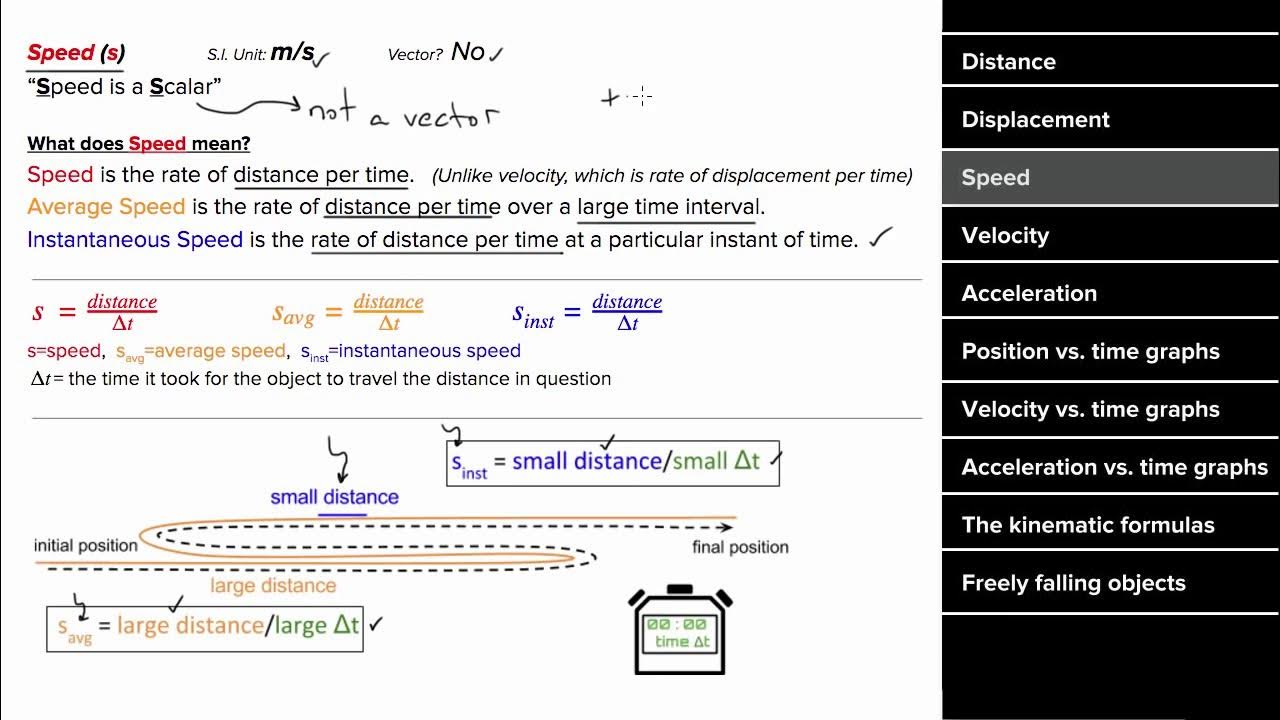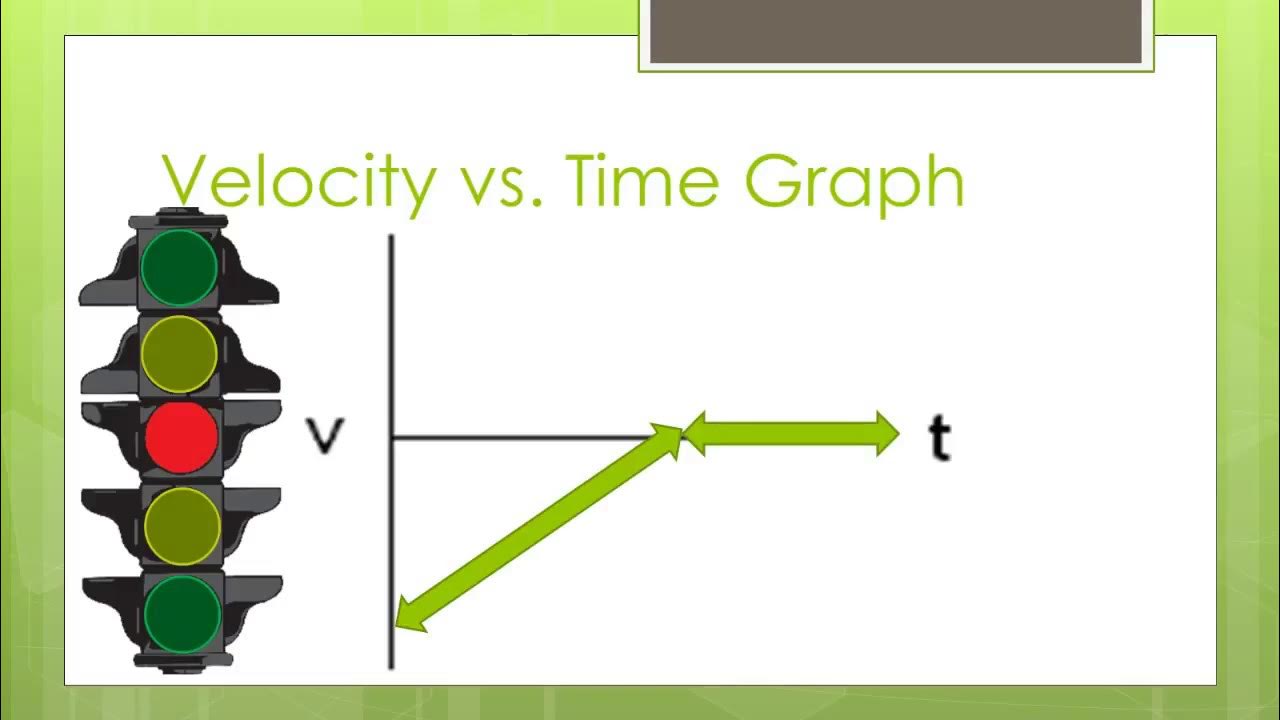AP Physics 1 | Unit 1: Kinematics
TLDRThis video script offers a comprehensive overview of Unit 1 of AP Physics 1, focusing on kinematics. It explains key concepts such as distance, displacement, speed, velocity, and acceleration, and their respective units. The script delves into motion time graphs, detailing position vs. time, velocity vs. time, and acceleration vs. time graphs. It also covers the 'big five' kinematic equations and their applications in solving problems related to free fall and projectile motion. The video concludes with a practical example of calculating the bridge's height and the stone's horizontal distance when thrown, emphasizing the importance of understanding kinematics for success in physics.
Takeaways
- 📏 Distance is the total path an object takes, while displacement is the change in position (denoted as Δx or Δs).
- 📌 Displacement is a vector with both magnitude and direction, whereas distance is a scalar with only magnitude.
- 🚗 For an object moving in a circular path, like a car driving around a circular road, the total displacement is zero if it returns to the starting point.
- 🏃 Speed is the distance covered per unit of time, whereas velocity is the displacement or change in distance over a given period of time.
- 📐 The SI units for velocity and speed are meters per second (m/s), and for acceleration are meters per second squared (m/s²).
- 🔄 In motion time graphs, the slope of the position vs. time graph represents velocity, and the area under the curve represents distance.
- 📈 The slope of the velocity vs. time graph indicates acceleration, and the area under this curve gives displacement.
- 🚀 In free fall problems, gravity is considered negative (-9.8 m/s² or -10 m/s²) because it acts downward, which is the opposite of the positive direction in most kinematic problems.
- 🌐 Projectile motion involves two dimensions (horizontal and vertical) and is influenced by gravity in the vertical direction and initial velocity in the horizontal direction.
- 📊 Analyzing motion time graphs can reveal whether an object is moving, accelerating, or decelerating by observing the slope and direction of the graph lines.
- 📚 The 'Big Five' kinematic equations are essential for solving one-dimensional kinematics problems, and they relate initial and final velocities, acceleration, time, and displacement.
Q & A
What is the main goal of the AP Cram program mentioned in the transcript?
-The main goal of the AP Cram program is to simplify AP subjects into a more understandable version for students.
How is displacement different from distance in the context of kinematics?
-Displacement is the change in position of an object and is a vector quantity with both magnitude and direction, while distance is the total path an object takes and is a scalar quantity with only magnitude.
What are the SI units for displacement and distance?
-The SI units for displacement are meters, and for distance, it is also meters.
Define speed and velocity according to the transcript.
-Speed is the distance an object moves over a given period of time, whereas velocity is the displacement or change in distance over a given period of time.
How is acceleration defined in kinematics?
-Acceleration is defined as the change in velocity over time, and its SI units are meters per second squared.
What does the slope of the position versus time graph represent?
-The slope of the position versus time graph represents velocity, as it shows how displacement changes over time.
What is the significance of the area under the curve in a velocity versus time graph?
-The area under the curve in a velocity versus time graph represents displacement, since velocity times time gives us displacement.
What is the relationship between the shape of the position graph and the acceleration?
-The shape of the position graph indicates the nature of acceleration. A positive exponential increase indicates positive acceleration, while a negative exponential decrease indicates negative acceleration.
How is the initial velocity of a ball thrown straight up into the air calculated using kinematic equations?
-The initial velocity can be calculated using the kinematic equation that relates final velocity, displacement, and acceleration (gravity). By rearranging the equation and solving for the initial velocity, we can find the required value.
In projectile motion, why does the horizontal velocity remain constant?
-The horizontal velocity remains constant in projectile motion because there is no acceleration in the horizontal direction; acceleration is a change in velocity, and without any horizontal acceleration, the horizontal velocity stays the same.
How can you determine the maximum height and horizontal distance of a projectile using kinematic equations?
-To determine the maximum height, use the vertical kinematic equation with the final vertical velocity being zero at the peak. For the horizontal distance, use the equation that relates horizontal velocity, time, and displacement.
Outlines
📚 Introduction to AP Physics 1: Kinematics
This paragraph introduces the first unit of AP Physics 1, focusing on kinematics. It explains the difference between distance and displacement, defining distance as the total path an object takes and displacement as the change in position. The distinction between scalar (distance) and vector (displacement) quantities is highlighted, as well as the definitions of speed and velocity. The concept of acceleration is introduced as the change in velocity over time, with examples provided to illustrate the calculations involved. The paragraph sets the stage for a deeper understanding of motion and its graphical representations.
📈 Understanding Motion Time Graphs
This section delves into the analysis of motion through time graphs, explaining position versus time, velocity versus time, and acceleration versus time graphs. It describes how the slope of these graphs represents velocity and acceleration (jerk), respectively, and how the area under the curve gives displacement or velocity. The paragraph also discusses how the direction of velocity and acceleration can be inferred from the position and velocity graphs, and provides examples to illustrate these concepts. It challenges the viewer to apply this knowledge to a given position versus time graph and convert it to a velocity versus time graph.
🚗 Kinematics in One Dimension and Free Fall
This part of the script covers the 'big five' kinematic equations used to solve one-dimensional motion problems and the concept of free fall. It explains how to calculate acceleration when time is not given, using a car's change in velocity as an example. The script then introduces the concept of free fall, where an object moves due to Earth's gravity, and provides a problem-solving example involving a ball thrown straight up in the air. The use of kinematic formulas to solve for initial velocity in free fall scenarios is demonstrated.
🏐 Projectile Motion and Problem Solving
The final paragraph discusses projectile motion, which involves the motion of objects in two dimensions (horizontal and vertical). It outlines the equations necessary for dealing with projectile motion and provides examples of how to solve problems involving horizontal and vertical components of motion. The script challenges the viewer to solve a problem involving a stone thrown from a bridge and explains how to find the height of the bridge and the horizontal distance the stone travels. It also touches on how to approach problems with given launch angles, using a soccer ball as an example.
Mindmap
Keywords
💡Kinematics
💡Displacement
💡Velocity
💡Acceleration
💡Motion Time Graphs
💡Free Fall
💡Projectile Motion
💡Big Five Equations
💡Jerk
💡Pomodoro Technique
Highlights
Introduction to AP Physics 1 and its focus on simplifying complex subjects.
Definition of distance and displacement, with examples and SI units.
Explanation of the difference between speed and velocity, including their SI units.
Formula for acceleration and its calculation with an example.
Discussion of motion time graphs, including position vs. time and velocity vs. time graphs.
Interpretation of position vs. time graphs for different types of motion.
Overview of the 'big five' kinematic equations for one-dimensional motion.
Example problem solving using the big five equations to find car acceleration.
Explanation of free fall motion and its relation to gravity.
Solution to a free fall problem involving a ball thrown vertically upwards.
Introduction to projectile motion, including horizontal and vertical components.
Solution to a projectile motion problem involving a stone thrown horizontally.
Method for solving projectile motion problems with launch angles and initial velocities.
Summary of the key concepts covered in Unit 1 of AP Physics 1, including kinematics, free fall, and projectile motion.
Encouragement to use the knowledge gained in the study of AP Physics 1 for future success.
Transcripts
5.0 / 5 (0 votes)
Thanks for rating:





